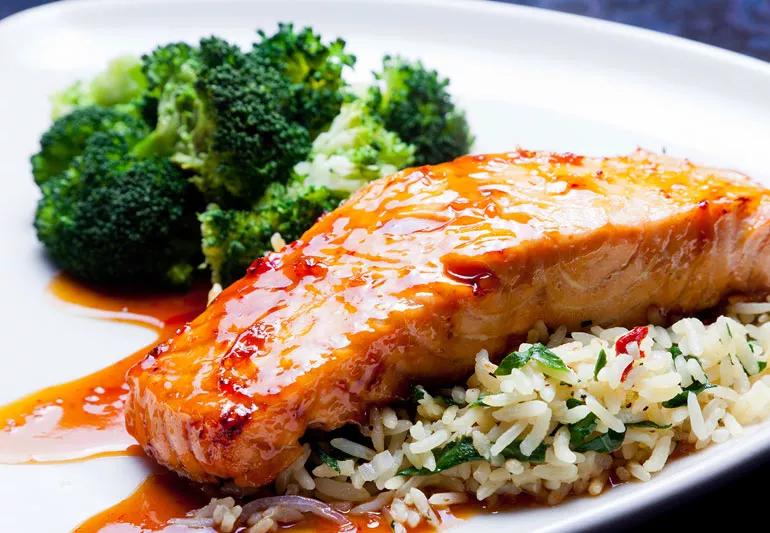Fish, cruciferous veggies, turmeric, yogurt, ginger and green tea all reduce inflammation

You may already be taking medicines — either prescription or over the counter — to relieve stiffness, inflammation and pain in your joints. But long-term use of nonsteroidal anti-inflammatory drugs (NSAIDs) can damage your body — especially your liver and kidneys. NSAIDs can also have unpleasant gastrointestinal side effects.
Advertisement
Cleveland Clinic is a non-profit academic medical center. Advertising on our site helps support our mission. We do not endorse non-Cleveland Clinic products or services. Policy
Wouldn’t it be great if you didn’t have to take these pain medications so often, or at all? It’s possible that modifying your eating habits could help you do just that.
Have you ever heard the phrase “food is medicine”? Well, there’s an abundance of scientific evidence to suggest that — when it comes to joint issues — it is! Adding certain foods, spices and supplements to your diet (and cutting back on foods that feed inflammation) can make a big difference in your quality of life.
Registered dietitian Maxine Smith, RD, LD, shares six healthy foods that may help ease your joint pain, highlights those foods that need to be avoided and recommends a joint-friendly eating plan.
Now, Smith isn’t claiming that food can reverse the effects of osteoarthritis, or that a change of diet can eliminate your pain completely. Most joint pain requires a combination of different treatment approaches, including medications, exercise, physical therapy and other lifestyle changes.
But Smith is saying that a carefully curated diet is an important — and often overlooked — piece in the complex puzzle that is joint care. An eating plan centered on inflammation reduction can lessen pain in much the same way over-the-counter NSAIDs do.
Advertisement
Side note: If you aren’t yet experiencing joint pain, Smith says that making good food choices now may help you keep it that way.
Inflammation is what happens when your body’s immune system gets … overexcited. If you cut yourself, your body responds by sending a horde of white blood cells to the wound to protect against infection. That’s a good thing: It’s a crucial part of the healing process.
Inflammation becomes a problem when it’s chronic — when it decides to stick around long after it’s needed. It doesn’t have enough work to do, so it keeps itself busy by bothering healthy parts of your body. If you have a joint condition like arthritis, it’s not just the result of the wear and tear that comes from getting older. Inflammation is also in the picture.
“Our goal isn’t to eliminate inflammation,” Smith explains. “Inflammation serves an important purpose. We just want to reduce it, to make it more manageable and less widespread throughout the body.”
There are a lot of foods out there that have anti-inflammatory or pain-relieving properties. Smith selects six to start:
You could combine all six of these foods and make quite a tasty meal for yourself! But for now, let’s break down each ingredient to find out how it can help you manage your joint pain.
Fish are rich in omega-3 fatty acids, which have anti-inflammatory properties. Ideally, you want to eat fish that’s both high in omega-3 and low in mercury. A few fish that meet that criteria are:
Fish isn’t typically an everyday food outside of coastal communities, so you might be wondering if you could just take a fish oil supplement instead. It might be an option, but you should definitely discuss it with a healthcare provider first. Smith also notes that you may be robbing yourself of other important nutrients that fish offers. Instead of popping a pill, consider going for frozen or canned fish. It’s convenient, healthy and tasty and can help keep inflammation in check!
“In addition to other vegetables, be sure to enjoy a host of cruciferous vegetables such as broccoli, cauliflower, Brussels sprouts or kale,” Smith recommends. “These are all nutritional powerhouses, chock full of phytochemicals like sulforaphane, which has potent anti-inflammatory properties.”
Dark green leafy vegetables and orange vegetables are other important vegetable groups to work into your daily menus. Salads, soups, bowls and stir-fries are an excellent way to get all these in a single dish.
Advertisement
Turmeric — the bright yellow spice that you’ll find in many of your favorite curry dishes and that makes mustard yellow — has been used to calm painful, swollen joints for millennia. The pain-relieving ability can be credited to the curcumin in turmeric. Unfortunately, curcumin isn’t well used by the body, although consuming it with black pepper, healthy fats such as olive oil and in a heated dish can improve the absorption. A concentrated supplement can be the way to go if targeting pain relief. The types and dosages vary, so be sure to discuss any supplements with a physician before taking them.
A healthy gut is of prime importance when it comes to managing inflammation. According to Smith, regularly eating fermented foods — like yogurt — provides bacteria that help create a healthy gut microbiome.
When you shop for yogurt, she recommends reviewing the nutrition facts label on the container to be sure it contains live and active yogurt cultures. Plain and unsweetened yogurts are the healthiest option, but don’t worry about being bored. “You can always enhance the flavor with an array of fruit, adding to the yogurt’s anti-inflammatory benefits!” she suggests.
At some point in your life, somebody’s probably given you something with ginger in it to settle an upset stomach. But did you know that ginger’s also great for more than just a crummy tummy?
Advertisement
“Ginger has antioxidant properties and reduces inflammatory enzymes,” Smith explains. “That’s, in part, thanks to a compound in ginger called gingerol.” The name sounds made up, but there’s nothing fake about gingerol’s impact. Clinical trials have shown that ginger is helpful for dealing with a wide range of inflammatory conditions, from osteoarthritis to lupus.
With ginger, Smith notes that preparation is important. “When ginger is heated, such as in curries and soups, gingerol gets converted into shogaols, which have more powerful anti-inflammatory potential.”
Green tea is one of the most popular beverages in the world. It’s also a nutritional powerhouse. It’s rich in polyphenolic compounds that help reduce inflammation across the board, not just in your joints.
Quality matters with tea — and not just because it impacts the taste. In order to minimize the potential for consuming pesticides and herbicides, Smith recommends buying loose-leaf tea and rinsing it in water before steeping. Alternatively, consider purchasing a USDA- or Euro-leaf organic-certified tea.
Having a few foods on hand to help when you’re feeling stiffer and more swollen than usual is great. But what if you want to create lasting change?
Advertisement
The health benefits of the Mediterranean diet have been well established at this point. You may think of it as a go-to eating plan for heart health — and it is. But that’s just one of a long, long list of reasons to give it a try. The Mediterranean diet’s also great at combatting inflammation. So great, in fact, that some people find they no longer need NSAIDs to treat their pain after a short time following the eating plan.
Eating a Mediterranean diet means eating:
Notice that you don’t see a lot of processed food, red meat, alcohol, refined grains, sugars or dairy in that list? There’s a good reason for that: Those categories of food are known for stimulating inflammation.
In addition to eating foods with anti-inflammatory properties, you can also improve joint pain and stiffness by avoiding foods that kick swelling into high gear.
“Sugars and refined grains, including white rice, pasta and white bread, are some of the worst culprits when it comes to inflammation,” Smith states.
Try limiting daily added sugar to six teaspoons for women. Men should restrict their intake to no more than nine teaspoons. Sugar hides in many foods from ketchup to cereals, so remember to be a label detective!
Another area to avoid: Unhealthy fats. “Choose healthy plant-based fats such as olive oil, avocado, flaxseeds, chia seeds, walnuts and hempseeds,” Smith advises. “They offer nutrients such as vitamins and minerals, antioxidants and fiber. They also have anti-inflammatory potential.” She also encourages eating fatty fish like salmon, saying, “They are by far the best sources of omega-3 fats.”
Smith also recommends limiting omega-6 fatty acids, which are often found in processed foods. While omega-6 fatty acids are healthy, we tend to eat way more than we need. Sources include corn oil, safflower oil, sunflower oil, peanut oil, grapeseed oil and vegetable oil. It’s common to use these oils in mayonnaise and salad dressing, so, again, you’ll have to do some label reading.
The fat in certain dairy products, fatty meats and chicken skin can also contribute to joint pain and swelling — another reason why plant-centric eating plans like the Mediterranean diet tend to reduce inflammation levels.
It’s true that “food is medicine.” But if you feel like you’ve cleaned up your diet and are still experiencing joint inflammation and pain, it’s time to seek additional health support.
First things first: Talk to your primary care provider or — if you have one — your rheumatologist. They’ll check to see if your joint issues are a sign of an underlying medical condition. If you already have a diagnosis, increased pain and inflammation may be a sign that your treatment plan needs to change.
If you’re not already working with a pain management specialist, a provider may consider referring you to one for additional support.
Once you’ve ruled out any issues with the joints themselves, get connected with a registered dietitian. They can help you determine if you have any food sensitivities or intolerances that might be impacting your inflammation levels. They can also personalize your eating plan so that it better fits your needs.
Learn more about our editorial process.
Advertisement

It’s a normal, common occurrence, but popping with pain or swelling may be a sign of an injury

As long as it’s done correctly, knuckle cracking is safe

The goal is a balance of aerobic activity, flexibility exercises and muscle strengthening

Edamame, lentils and chicken breast are good sources of protein

This powerful antioxidant does more than fight colds — it keeps you healthy inside and out

Eating this root vegetable can help support your eye, heart and brain health

The flavorful herb is full of antioxidants that may help regulate blood sugar

Too much sodium can cause high blood pressure and increase your risk of heart disease

The best parenting style balances enforcing rules and showing plenty of love

Tips include cutting back on sugar, focusing on exercise and managing stress

It can be harder to let go when you’ve invested time, energy and emotions — but it might be the healthier choice long term